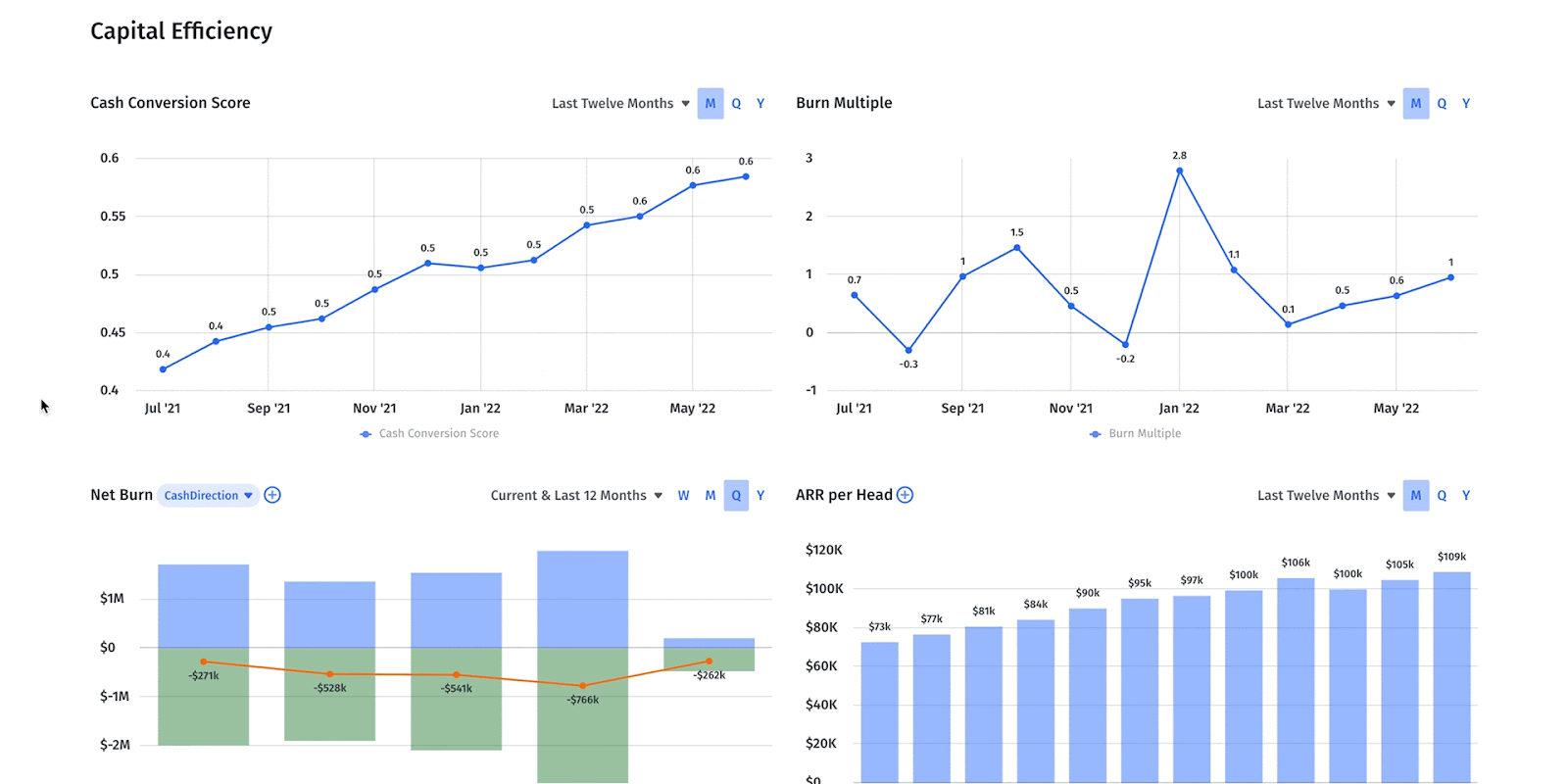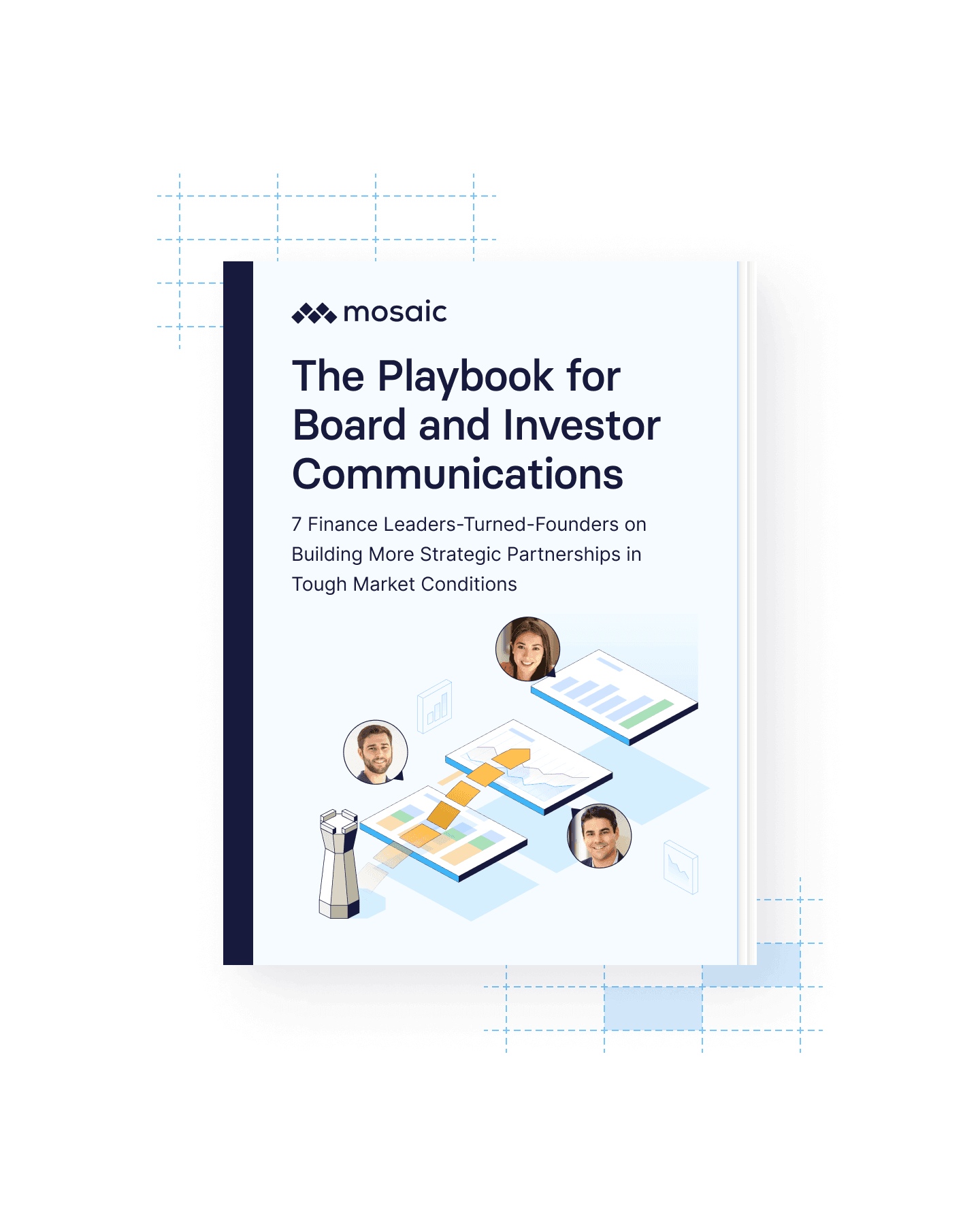Building strong relationships with investors is vital for any non-bootstrapped business. But your investors aren’t in the weeds of the day-to-day work with you. That’s why investor updates are so important in the investor-executive relationship.
Investor updates give you a chance to share context about business performance and plans in between board meetings. And when done well, consistently sharing that context helps you unlock the value of your investors (beyond the money they put into your business).
Don’t leave your investors in the dark between board meetings. Take the time to craft regular updates that convey the numbers and also leverage financial storytelling skills to explain the “why” behind performance.
Table of Contents
What Are Investor Updates?
Investor updates are documents shared at regular intervals — ideally at least monthly — to give investors news and information about the business. They’re a way to connect with investors and provide insight into growth trajectory, performance to plans, and capital efficiency.
The timing and frequency of your investor updates may depend on the current state of both your business and the market. When venture funds were flowing freely, and the economy was thriving, you may have gotten by with infrequent investor updates. Heading into 2023 with so much market uncertainty, increasing the frequency of investor updates is critical.
Best-in-class executives always stay on top of investor updates. But according to Jason Lemkin at SaaStr, the expectations are higher for everyone now.

From Jason Lemkin, Founder of SaaStr, on Twitter
How Do Company Updates Differ for Different Investors?
You can think about your investors in two tiers — the insiders who get board meeting access and the less-involved shareholders on your cap table.
The difference in how you update these two tiers of investors is about access. You give insiders a deeper level of information while running board meetings, digging deep into the granular details of business performance to diagnose opportunities and issues.
But the less-involved stakeholders get a higher-level update. The general investor update should include enough information to show how your business is tracking against goals. Include any information you’d be willing to share with a broader audience of the investing community. You can assume the investor update will have more visibility beyond the group you share it with, so anything that you want to keep private should stay in the official board deck.
How to Use Software to Increase Transparency & Trust with Investors
Benefits of Investor Updates
Regular updates allow the business to nurture strong relationships and keep investors up-to-date and involved with the company.
Here are some benefits of sending out consistent investor updates.
Consistent Communication Builds Trust
Consistent, reliable communication with stakeholders shows investors know how things are going with the business. That transparency helps build trust in the company.
Updates Show Investors How They Can Help
Providing the right KPIs gives investors strategic insight into how they can collaborate to help with business success. For example, investors may see opportunities in high-level plans to recommend stand-out candidates or new hires for open roles.
Updates Show Opportunities for Follow-on Funding
When you show investors how their money has been put to work to execute goals, they’re more likely to want to invest more to help the business grow and succeed, whether it’s independently or in future funding rounds.
Investors Can Share Expertise With the Business
Investors have a lot of collective knowledge relevant to the business in a variety of different areas. The more the business communicates with investors, the easier it is for them to serve as mentors and leverage their expertise to help the company.
Updates Hold the Business Accountable
Sharing KPIs and reflections on results holds business leaders accountable for performance. It also gives investors a chance to challenge financial assumptions and make observations, so you adjust plans as needed.
Build Your Investor Update Template
There’s no one-size-fits-all way to provide an investor update. But whether you’re creating a slide deck, sharing a Loom overview, or writing out a memo, your investor update should include the following information:
- A message from the founders or top executives.
- A summary of the current state of the business.
- Any areas where investors can help or offer support.
- Your most important metrics and KPIs.
- Department highlights and challenges.
- Business goals before the next update.
Whichever format you choose, there’s one thing to keep in mind — keep it consistent each time you share an update. A consistent format makes life easier for you because you can swap updated information out in the template. And it also helps investors better understand the growth journey that your business is following.
Metrics That Matter for Investor Updates
The metrics you share should show that the business understands what is important to investors. Whether it’s a metric that’s trending lower than investors might like or developing proactive strategies for growth, investors want to see that you’re planning ahead.
You also want to make sure that you’re using the metrics to explain the right narrative about your business. It’s about explaining the “why” behind your numbers, not just sharing a laundry list of relevant metrics.
The specific metrics you focus on will depend on the maturity of your business, your business and go-to-market models, and overall performance to plan. But as you think through the narrative, you’ll want to include metrics that cover operational efficiency, state of the sales pipeline, go-to-market efficiency, revenue growth, and retention, at the very least.
Here are some of the specific metrics that you should consider using to update your SaaS investors.
Cash Conversion Score
This critical capital efficiency metric measures current return on investment (ROI) of dollars put into the business. For SaaS businesses, this metric is essential to give investors a deeper understanding of recurring revenue as a proxy for ROI. When combined with other metrics, your cash conversion score provides deeper insight into market/product fit, as well as the scalability of sales and marketing teams.
Burn Multiple
Sharing your burn multiple gives investors insight into how much revenue the business generates per dollar burned. This shows how efficiently your company can generate revenue using capital raised from funding rounds. Investors like this metric since it demonstrates how well the business distributes capital across the business. It also provides strategic insight into potentially extending the company’s runway via proactive cash management.
Gross Margin
Your gross margin is the percentage of income the business is left with after subtracting the cost of goods and services or the cost of revenue. Gross margin shows investors the percentage of money the company gets to keep compared to the amount of money the company brings in.
SaaS Quick Ratio
The SaaS quick ratio compares monthly recurring revenue (MRR) against expenses to measure startup cash flow. This highlights your ratio of MRR growth compared to churn and contraction MRR. It’s an at-a-glance directional financial metric for comparing top-line and bottom-line growth and stability. It shouldn’t be used alone to judge the financial health of the business, though, so make sure investors know it’s just part of the picture.
Net Dollar Retention (NDR)
Also called net revenue retention (NRR), this metric compares the revenue earned from customers at the start of a given period to the revenue earned from them at the end of the period. This helps define lost revenue from customer churn or downgrades, as well as any increases in total revenue over a specified period. For SaaS businesses, this important metric gives insight into customer success, renewals, and upsells of the product. Investors want to see that you’re not only retaining customers but also effectively managing customer retention costs to ensure profitability.
LTV/CAC Ratio
The LTV/CAC ratio measures the relationship between the company’s customer lifetime value (LTV) and customer acquisition cost (CAC). This ratio shows your ROI based on how much it cost the business to get a new customer and what they’ve paid the business thus far. This financial efficiency metric is helpful for gauging the company’s profitability now and in the future.
CAC Ratio
The CAC ratio is the cost to acquire annual recurring revenue (ARR). This financial metric provides insights into the relationship between new bookings and upsells and the company’s marketing, showing investors if current marketing strategies are effective.
CAC Payback Period
The CAC payback period is the amount of time it takes to recover acquisition costs per customer. Investors are interested in this metric because it shows a company’s ability to achieve returns on acquisition costs alongside invested capital.
SaaS Rule of 40
This financial ratio is used by SaaS companies to compare the company’s revenue growth to its profitability. The SaaS rule of 40 states that a healthy SaaS business has a combined growth rate and profit margin of at least 40%. It’s a great at-a-glance indicator of the company’s performance and sustainability for investors because a business can still be considered healthy even if it’s unprofitable or the growth rate falls as long as the combined ratio is 40% or more.
Investor Update Example
In 2020, job search and recruitment platform Untapped tripled its headcount and revenue, opening the opportunity for the next round of funding. As Untapped prepared for that funding round, they needed to tell investors their financial story and the story of their future growth. Their investor update provided metrics that delivered a compelling growth narrative.
Here’s a high-level outline of what that investor update example might have looked like.
Sample Investor Update Outline
Executive Summary
- Brief introduction from executives
- ARR with context, explaining how Untapped tripled its revenue
- Expenses with context, explaining how Untapped tripled its headcount
- Burn multiple to show financial efficiency and potential to extend runway
- LTV/CAC ratio analysis to show ROI based on CAC
- Milestones achieved thus far
Investor Asks
- Funding to help support growth
- Leads for open roles from diverse backgrounds
KPIs and Results
- Modeling complex scenarios around headcount growth
- Reviewing ROI on sales and marketing spend
- Analysis of CAC ratio to access marketing success
- CAC payback period for strategic insight into ability to achieve returns on investments
Department Highlights
- Updates on customer acquisition and active users
- Sales and Marketing pipeline and targeting plan updates
- Customer retention metrics, KPIs, and trends
- New programs/tools implemented or upgraded
- Major role changes or introductions
Goals
- Scenario planning to help achieve goals
- Plans for future business growth
- Fundraising goals for next steps
How to Write An Investor Update
Writing an investor update doesn’t need to be time-consuming, and it doesn’t need to share too many details. Whether it’s a quarterly or monthly update, it should provide an overview of how things are trending, including key metrics that show highlights, challenges, and areas the business could use help from investors.
Here’s how you can approach the most common sections of the typical investor update.
Executive Summary
After a brief introduction, provide a summary of the company’s finances and operations. Typically, there’s a brief summary for each department. In a SaaS company, that should include finance, sales, marketing, operations, product, and engineering.
Summaries don’t need to include anything sensitive but should include some quantitative measuring of major milestones and any significant challenges. Consider including at-a-glance financial metrics like your gross margin, burn multiple, cash conversion score, LTV/CAC ratio, and SaaS quick ratio.
Areas Investors Can Help
Investors want to help the business succeed, so it’s important to tell them exactly how they can do that. Offer crisp, clear information about how investors can contribute.
Maybe that means getting warm introductions to candidates for open executive roles. Or an introduction to someone involved at a company that’s a key partnership opportunity. In some cases, you may be able to get another perspective on a particular operational challenge you’re facing. And maybe more commonly, it could be surfacing the opportunity to be involved in an upcoming funding round.
Results and KPIs
While investors prize MRR/ARR and net dollar retention, be conservative with what else you share. Outside of board meetings, only share KPIs you’re comfortable sharing with potential new investors or the general market. Also consider including some findings from scenario planning here, with outputs from worst, base, and best-case models you’re comfortable sharing. You want to show growth, operational efficiency, and financial efficiency while addressing any challenges the business experienced by providing context and plans for improvement.
Department Highlights and Goals
Break down the business by department and share initiatives and progress on goals in each department. CAC ratio and burn rate will be relevant here. Your department-level updates should include some insight into performance to plan and an overview of how headcount has changed and will change in each area.
Simplify Investor Updates with Mosaic
Investor updates should tell the company’s financial story with your metrics. But that requires context, so your investors really get the “why” behind the numbers. These updates should be proactive and action-oriented, so the takeaway is that the company is prepared for agile scenario planning, addressing any challenges, and making adjustments to meet goals and improve efficiency.
The finance team needs access to the latest numbers and time to collaborate with executive leadership on strategic insights and the metrics that matter.
Mosaic gives you access to real-time data, so you get automated calculations and forecasts without hours of manual work to compile the necessary data. With Mosaic’s templates, dashboards, and metric visualizations, you can show investors the trends and at-a-glance projections that tell your financial story. These analytic tools connect to systems you already use, allowing you faster, real-time access to the metrics that matter.
For investor updates, Mosaic offers an operational efficiency dashboard that brings your story around capital efficiency and profitability to life.

You can also create custom dashboards from scratch to ensure you present the right metrics at the opportune time. And with role-based permissions, you can share the canvas directly with investors so they can always check in on company performance.
Don’t give investors backward-looking data points. Show you have your eye on the future and the company’s potential to grow and succeed. Mosaic’s finance automation helps you demonstrate proactive financial analysis and strategic insight into improved operational efficiency, profitability, and growth for the business. Financial data analysis software, like Mosaic, can empower you to create dynamic forecasts and projections that offer a forward-looking perspective to investors.
Request a personalized demo today and discover how Mosaic can help you create investor updates that instill confidence and keep investors engaged.
FAQs About Investor Updates
What are the main components of an investor update?
Investor updates will vary based on the needs and circumstances of your business, but generally your update should include:
- An executive summary
- A section where you ask investors for input on any issues or questions you have
- A section where you walk through important metrics, KPIs, and financials
- Department-by-department summaries and updates
- Updates on goals and and growth plans
How often should investor updates be delivered?
What format should investor updates be delivered in?
Own the of your business.


